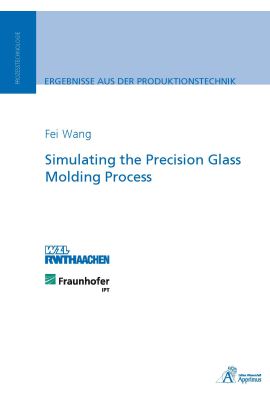Over the past two decades, precision glass molding has gradually become a competitive
hot-replicating manufacturing technology for precision glass optical components. But
form errors occur on surface of molded glass optics as a result of a diverse range of effects
including viscoelastic relaxation and thermal shrinkage of optical glass material during the
molding and cooling processes. Conventionally these errors can be compensated solely
via time-consuming and cost-intensive try-out molding experiments.
The target of this thesis was to provide an efficient substitution by developing of a quantitative
numerical method to model the precision glass molding process. With this method,
the final shrinkage error can be predicted before the actual mold manufacturing commences.
To achieve this goal, systematic research was required on the development of reliable
thermal and structural models based on system analysis, measurement of key material
properties and the qualification of this model through diverse case studies.
The process simulation was developed in a commercial FEM code, in the form of a combined
metaphysical model. Maxwell model and the Arrhenius shift function were used to
calculate the viscoelastic deformations of the glass material. The contact conditions, heat
conduction, friction and other boundary conditions are factored into calculations, based
on a system analysis of the molding process.
In addition, the determination methods for relaxation behavior of glass and its temperature
dependency, effective thermal conductivity and coefficient of thermal expansion
of applied optical glass material as well as the friction behavior between glass and mold
material at high temperature were successfully developed on a commercial production
machine and can be standardized for further glass-mold material combinations.
Towards the end of the thesis, the developed numerical simulation method was applied
to several case studies including a range of aspherical lenses, a cylinder lens array and free
form lenses. Comparison of the geometrical deviations obtained in both the simulation
and experimental approach showed good coherence and most deviations in-between
were less than 2 μm.
With the developed numerical simulation model and property measurement methods,
this research provided the optical manufacturers an opportunity to achieve a lower production
cost and a shorter development time by compression molding of precision glass
components.
| Autor | Wang, Fei |
|---|---|
| Lieferzeit | 3-4 Tage |
| Gewicht | 0.3 kg |
| Erscheinungsdatum | 22.04.2014 |
Eigene Bewertung schreiben
Prozesstechnologie
Simulating the Precision Glass Molding Process
ISBN: 978-3-86359-193-9
39,00 €
inkl. 7% MwSt.
Kurzbeschreibung
Over the past two decades, precision glass molding has gradually become a competitive hot-replicating manufacturing technology for precision glass optical components. But form errors occur on surface of molded glass optics as a result of a diverse range of effects including viscoelastic relaxation and thermal shrinkage of optical glass material during the molding and cooling processes. Conventionally these errors can be compensated solely via time-consuming and cost-intensive try-out molding experiments.
Auf Lager

